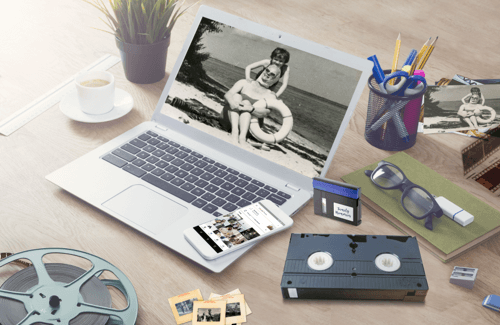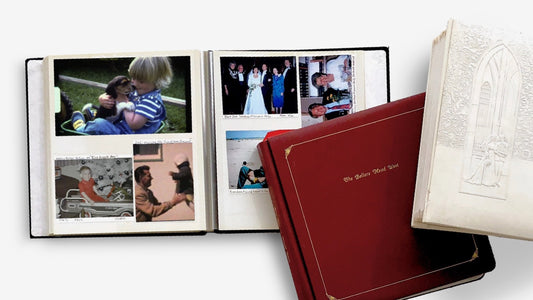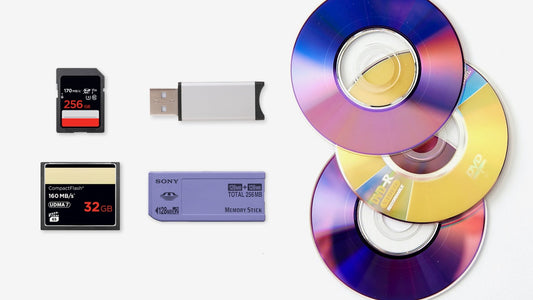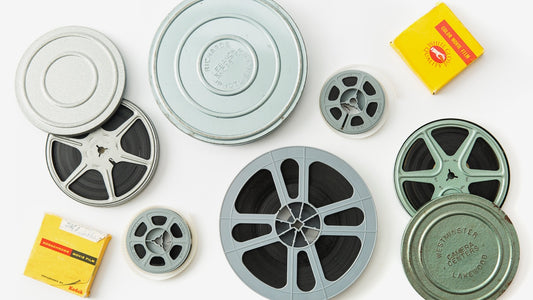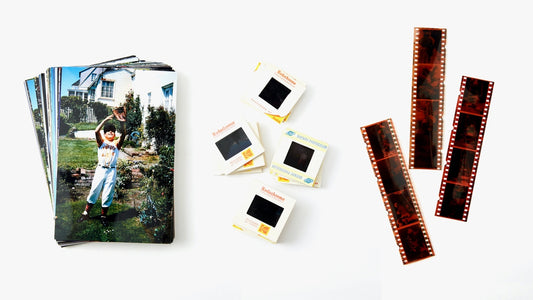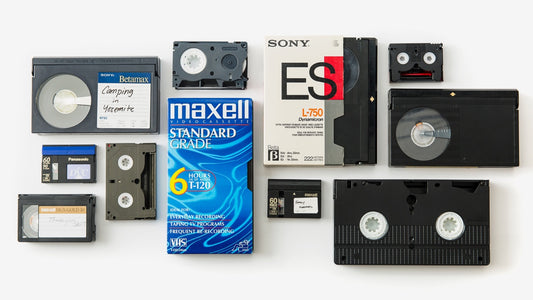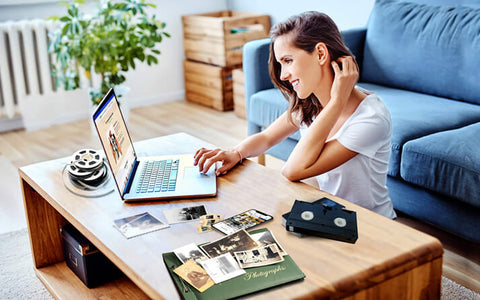Let’s be honest: no one wants to sit through three hours of raw footage from a 1994 family vacation. The shaky camera work, the long shots of nothing… it can be a chore. The real magic happens when you turn that footage into a concise, engaging story. When you edit digitized home movies, you get to be the storyteller. You curate the best moments—the laughter, the milestones, the candid interactions—and create a final product that’s a joy to watch. We’ll show you exactly how to trim the fluff and combine the highlights into a family movie night feature.
Key Takeaways
-
Organize your files before you start editing: Set yourself up for success by creating a simple folder structure and using a consistent naming system, like
YYYYMMDD_EventName. This makes finding the right clips easy and keeps your project from getting messy. - Focus on the fundamentals, not flashy effects: The most impactful edits are often the simplest. Concentrate on trimming unnecessary footage, arranging clips to tell a clear story, making basic color corrections, and ensuring the audio is balanced and easy to hear.
- Create a plan to preserve and share your final movie: Protect your hard work by following the 3-2-1 backup rule—three copies, on two different media types, with one off-site. Use cloud services to create a shareable link so your family can easily access and enjoy the memories.
Your First Steps to Editing Digitized Home Movies
Now for the fun part! You’ve taken the most important step by preserving your memories through a video transfer service, and now you have a collection of digital files ready to be polished. Diving into video editing might sound technical, but it’s really just about weaving your favorite moments together to tell a story. Think of it less like a Hollywood production and more like creating a digital scrapbook. You’re simply choosing the best clips, arranging them in an order that makes sense, and trimming away the shaky or uninteresting bits.
The goal isn’t to create a flawless blockbuster but to craft a heartfelt movie that you and your family will actually want to watch again and again. Before you start cutting and combining clips, a little bit of preparation will make the entire process smoother and much more enjoyable. By taking a few minutes to organize your files and choose the right software, you’ll set yourself up for success. This initial setup helps you stay focused on the creative side of things—telling the story of your family’s precious moments.
What's in Your Digitized Movie Files?
Before you open any editing software, take some time to simply watch your newly digitized home movies. This helps you refamiliarize yourself with the footage and start spotting the moments that make you smile, laugh, or tear up. As you watch, jot down notes on the highlights you want to include. Once you have a feel for your content, it’s a great idea to rename your files. A clear labeling system will save you so much time later. Try a simple format like YearMonthDay_EventName, for example, 19951225_ChristmasMorning. This method, recommended by Forbes, makes it easy to find and sort your videos chronologically.
Why the Quality of Your Original Scan Matters
Think of your digitized footage as the foundation for your editing project. If you start with a shaky, blurry foundation, no amount of decorating will make the house sturdy. The same is true for your home movies. A high-quality scan captures the most detail, color, and clarity from your original tapes or film reels, which gives you a much better starting point for editing. When the initial footage is crisp, tasks like color correction are more effective, which makes the entire editing process smoother and more rewarding. Trying to 'fix' a grainy or poorly lit video in post-production can be frustrating, as some details are simply lost in a low-quality transfer. Investing in a professional service ensures you have the best possible raw material to work with, setting you up for a final movie you’ll be proud of.
What's the Right Editing Software for You?
You don’t need expensive, professional software to edit home movies. In fact, your computer probably already has a free, user-friendly program installed, like iMovie for Mac or Video Editor for Windows. These are perfect for beginners and have all the basic tools you’ll need. If you want to try something with a few more features without a price tag, consider a program like Lightworks. Its free version includes professional-grade editing tools that are surprisingly intuitive. The best software for you is the one that feels comfortable and doesn’t get in the way of your creativity. Start simple, and you can always explore more advanced options later.
For Windows Users: Clipchamp
If you’re working on a Windows computer, your best starting point is likely already installed. Windows 11 comes with a built-in video editor called Clipchamp, which is fantastic for handling the basics. If you're on Windows 10, you can easily download it from the Microsoft Store. Clipchamp is designed to be straightforward, allowing you to trim clips, add simple transitions, and arrange your favorite scenes without getting bogged down by complicated features. It’s the perfect tool for turning your raw digitized footage into a polished family movie. You don't need to be a tech wizard to use it; its simple interface lets you focus on the story you want to tell with your precious memories.
For Mac Users: Final Cut Pro vs. iMovie
For Mac users, the choice often comes down to two main programs: iMovie and Final Cut Pro. Every Mac comes with iMovie, and it’s incredibly intuitive for beginners. You can easily drag and drop clips, add titles, and piece together a beautiful movie in no time. However, one of its drawbacks is the limited control over color correction, which can be a big deal when you’re working with older footage that might have faded. If you find your videos need a bit more life brought back into them, you might consider Final Cut Pro. While it has a steeper learning curve and comes with a price tag, it offers powerful tools for color grading and organizing your clips with keywords and markers. For most simple projects, iMovie is more than enough, but if you want professional-level control to really make your memories shine, exploring Final Cut Pro is a worthwhile step.
Must-Have Features in Editing Software
When you’re just starting, it’s easy to get distracted by flashy transitions and special effects. However, the most important features are the simplest ones. Look for software that makes it easy to trim the beginning and end of clips, combine multiple clips on a timeline, add simple text for titles or dates, and import music. A well-edited video is ultimately about telling a clear story, not about how many fancy wipes or starbursts you can add. Focus on the fundamentals, and you’ll create a video that feels authentic and timeless. The best edits are often the ones you don’t even notice.
How to Set Up Your Workspace for Success
A little organization goes a long way. Before you import a single clip, create a dedicated folder on your computer for your video project. Inside that main folder, create subfolders for your raw footage, project files, music, and final exported videos. This simple step is crucial because it keeps all your assets in one place and prevents the frustrating search for a missing file later on. As experts at Augmentify suggest, organizing your files correctly from the start is one of the easiest ways to ensure a smooth editing process. This clean workspace lets you focus on being creative instead of managing a mess of files.
Simple Edits, Big Impact: The Basics
Once your home movies are digitized, you have the creative freedom to turn hours of footage into a polished, watchable story. Don't worry, you don’t need to be a Hollywood director to make your videos shine. Basic editing is all about selecting the best moments and presenting them in a way that’s enjoyable for everyone. Think of it as creating a highlight reel of your family’s most precious memories.
The goal isn’t to add flashy special effects but to make the viewing experience better. By trimming unnecessary parts, organizing clips logically, and making small adjustments to the sound and picture, you can create a final video that your family will want to watch over and over again. Let’s walk through a few simple techniques that will make a huge difference.
Protect Your Originals: Make a Copy First
Before you make a single cut, the most important step is to create a complete copy of your digitized video files. Think of your original files as the master tapes—they are the pristine, untouched versions of your precious memories. Editing involves trimming, rearranging, and sometimes deleting footage, and mistakes can happen. By working from a copy, you give yourself a safety net. If you ever want to start over or create a different version of your movie, you can always go back to the original, unharmed files. Simply create a folder on your computer labeled “Originals,” duplicate all your videos into it, and then import the copied files into your editing software. This simple action keeps your original videos safe and is the best habit you can build as a new editor.
Start by Organizing Your Footage
Before you even think about making your first cut, take a moment to get organized. This is the single most important step to save yourself from future headaches. Start by creating a main folder on your computer for your project, like "Smith Family 1992." Inside that folder, create subfolders for your raw video transfer files, edited clips, music, and any photos you might want to add.
Next, rename your video files with a consistent format. Something like "1992-07-04_Beach-Trip_01" is much more helpful than "MOV_0451." This simple habit makes it easy to find specific moments later on. A little bit of prep work here makes the entire editing process smoother and more enjoyable.
Advanced Organization with Keywords and Markers
Once your files are neatly named and sorted into folders, you can take your organization a step further inside your editing software. Most programs allow you to add keywords or markers directly to your video clips. Think of keywords as digital labels; you can tag a clip with terms like "Dad's Birthday," "Summer Vacation," or "Sarah's First Steps." Later, when you want to create a montage of all the birthday parties, you can simply search for that keyword, and the software will pull up every relevant clip. Markers are similar but act like bookmarks within a single clip, letting you pinpoint an exact moment—like the instant the birthday candles are blown out. This method is a game-changer for managing large amounts of footage. As some editors on forums like Reddit point out, a good keywording system helps you quickly find the best moments, letting you focus on telling a great story instead of searching for that one specific shot.
Making the Cut: How to Trim and Combine
Your original home movies probably have some shaky camera work, moments where nothing is happening, or shots of the ground. The first real editing task is to trim the fat. Go through each clip and cut out the parts you don’t need, leaving only the golden moments. Most editing software makes this easy with simple drag-and-drop tools.
Once you have your collection of best moments, you can start combining them. Think about the story you want to tell. You might arrange clips chronologically to show a family vacation from start to finish, or you could group together all the birthday parties from different years. This is where you become the storyteller, piecing together individual memories into a cohesive narrative.
Adding Polish with Transitions and Effects
Transitions are the bridges between your clips. While editing software offers tons of fun options like star wipes and page peels, the most effective transitions are often the simplest. A basic "cut" (where one clip instantly changes to the next) works perfectly most of the time. For a softer change, a "crossfade" (where one clip gently fades into the next) is a great choice.
The key is to use transitions sparingly and with purpose. A well-placed fade can signal the end of a scene or a passage of time. Overusing flashy effects can be distracting and take away from the home-movie charm. Your goal is to enhance the story, not to show off every button in your editing software.
How to Make Your Audio Sound Better
Great video with bad audio is hard to watch. While you can't magically fix every sound issue from old tapes, you can make significant improvements. The first step is to balance the volume levels across your clips so there are no sudden, jarring changes in sound. Most editing programs have simple tools to raise or lower the audio for each clip.
If you have distracting background noise like wind or a humming air conditioner, look for a "noise reduction" filter in your software. In cases where the original audio is unusable, don't be afraid to mute the clip entirely and lay a nice piece of instrumental music underneath it instead. This can turn a noisy, chaotic clip into a beautiful, reflective moment.
Working with Audio from Old Film Reels
A lot of older formats, like 8mm and Super 8 film, were silent. So when you get your film transfer files back, don't be surprised if many clips have no audio. See this as a blank canvas rather than a problem. It’s your chance to add a soundtrack that brings the visuals to life. You can find plenty of royalty-free music online that fits the mood and time period of your footage. A gentle piano piece can add a layer of emotion to a wedding scene, while a fun, upbeat track can make a birthday party feel even more celebratory. You could also record your own narration, sharing the story behind the silent moments. This personal touch can be incredibly powerful for future generations watching the film.
When and How to Add Text and Titles
Adding simple text is a fantastic way to give your audience context. A title card at the beginning, like "The Johnson Family Christmas 1998," sets the scene immediately. You can also use text overlays to identify people, places, or dates as they appear on screen. This is especially helpful for younger family members who might not recognize everyone in the videos.
When adding text, make sure it’s easy to read. Choose a simple, clean font and pick a color that contrasts well with the video background—white text with a thin black outline or drop shadow is a classic, readable choice. Keep the text on screen long enough for someone to comfortably read it, but not so long that it becomes a distraction.
From Good to Great: Polishing Your Video
Once your clips are in order, you can start polishing the visuals. This is where you can really make your old home movies shine and look more professional. Don't worry, you don't need to be a Hollywood editor to make a big impact. Many editing programs have automatic features that do most of the heavy lifting for you. A few simple tweaks to color, brightness, and stability can transform grainy, discolored footage into a clear and vibrant story. These small adjustments are key to creating a final video that your family will be excited to watch for years to come.
Bring Your Colors to Life with Correction
Have you ever noticed how old videos can have a strange yellow or blue tint? Color correction fixes that. The goal is to make the colors in your video look natural and consistent from one clip to the next. Most editing software offers automatic color correction tools that analyze your footage and adjust it for you. This simple step can instantly make your videos look cleaner and more professional, ensuring that a white wedding dress actually looks white, not beige. It creates a cohesive feel, so your final movie flows smoothly instead of feeling like a jumble of mismatched clips.
Understanding the Limits of Color Correction
While color correction can work wonders, it's important to remember that it can't create detail that isn't there. Think of it like restoring an old, faded photograph. You can bring back a lot of vibrancy, but if parts of the image are completely washed out by the sun, you can't magically repaint them. Similarly, if your original videotape has severe color bleed or was filmed in near-total darkness, editing software has its limits. Some issues, like extreme overexposure or out-of-focus shots, are often impossible to fix in post-production. The final result will always depend on the quality of the source material from your video transfer, which is why digitizing tapes sooner rather than later is so valuable.
Get the Lighting Right: White Balance & Exposure
Think of white balance as the foundation for accurate colors. It tells the camera what "true white" looks like, which helps all the other colors fall into place correctly. Adjusting this can remove unnatural color casts. Exposure is all about brightness. Old footage can often be too dark (underexposed) or too bright (overexposed). A quick adjustment can reveal details hidden in the shadows or tone down overly bright spots. Getting the exposure right is crucial for a balanced, easy-to-watch video. Most editing programs let you tweak these settings with simple sliders, giving you a lot of control over the final look.
Quick Fixes for Common Video Problems
When you combine clips filmed on different days, with different cameras, or in different lighting, you often end up with noticeable visual shifts. One clip might be warm and sunny, while the next is cool and dark. This color inconsistency can be jarring for the viewer and make your video feel disjointed. The color correction tools we just talked about are perfect for solving this. By applying similar color and exposure settings across your clips, you can create a seamless viewing experience where the focus stays on the memories, not the technical flaws.
Adjusting Playback Speed for Film
The original pacing of your home movies might not always capture the feeling of the moment. You might have long, slow pans across a landscape or a quick, chaotic scene that you wish you could savor. Adjusting the playback speed gives you creative control over the rhythm of your story. You can speed up a lengthy segment to create a fun time-lapse effect or slow down a key moment—like a wedding kiss or a baby’s first steps—to enhance its emotional impact. Most editing programs make this incredibly simple, often with a "speed" or "rate" setting. After you get your film transfer files, playing with the speed is a powerful way to emphasize the moments that matter most and keep your audience engaged from start to finish.
Smooth It Out: Stabilizing Shaky Video
Let’s be honest—a lot of old home movies are shaky. It’s hard to hold a camera perfectly still, especially one of those bulky, old-school camcorders. Luckily, you don’t have to live with dizzying footage. Most modern video editing software includes a stabilization feature that can smooth out the bumps and jitters. This tool analyzes the footage and subtly crops and repositions the frame to create a more stable shot. Using stabilization tools can make a massive difference, turning a hard-to-watch clip into a pleasant memory.
Removing Background Noise and Hiss
Great video is only half the battle; clear audio is just as important. Old tapes often have background hum, wind noise, or volume levels that go up and down. These issues can be distracting and make it hard to hear what people are saying. Take a moment to fix your audio by reducing background noise, evening out the volume, and maybe even adding a subtle music track. After all, the sounds of your family’s laughter are just as precious as the visuals, and ensuring they come through clearly is a key part of the home movie experience.
Special Considerations for Editing DVDs
If your home movies are on DVDs, the editing process has a couple of extra steps. Unlike the straightforward MP4 files you might get from a videotape transfer, DVDs store video in a specific folder structure that isn't designed for direct editing. Before you can start trimming and combining clips, you first need to extract the video from the disc and convert it into a friendly format that your editing software can handle. It might sound technical, but it’s a common task with plenty of user-friendly tools available to help. Think of it as unlocking your memories from their plastic case so you can give them the polish they deserve.
How to Get Video Files from a DVD
To get started, you’ll need a program that can “rip” the video from the DVD. This process simply copies the video content from the disc to your computer and converts it into a standard file type, like an MP4. An all-in-one tool like Movavi Video Suite is a great option because it’s designed to handle this entire workflow. It can extract the video files from your home movie DVDs and prepare them for editing. Once the files are converted and saved on your computer, you can import them into your chosen editing software just like any other video clip, making the rest of the process a breeze.
A Note on Copyright Law
It’s important to touch on the legal side of copying DVDs. The good news is, you are completely in the clear when it comes to your own home movies. It is perfectly legal to copy and edit DVDs that you created yourself. The legal restrictions only apply to commercially produced, copy-protected movies that you buy from a store. So, as long as you’re working with footage of your family’s birthday parties and vacations, you have nothing to worry about. You have the freedom to preserve, edit, and share those personal memories however you see fit.
How to Weave a Story from Your Home Movies
Once you’ve mastered the basic cuts and trims, you can start thinking like a storyteller. Your home movies aren't just random clips; they're a collection of precious moments that, when woven together, tell the story of your family. Editing is your chance to shape these moments into a narrative that’s not only fun to watch but also deeply meaningful. You don’t need to be a Hollywood director to do this. It’s about finding the heart of the footage and presenting it in a way that connects with your loved ones.
Think about the difference between a slideshow of random photos and a thoughtfully curated photo album. The album tells a story. Your edited home movie can do the same thing. By arranging clips in a specific order, adding music, and including a few well-placed titles, you can transform a box of old tapes into a family heirloom that will be cherished for generations. The goal is to create something that makes your family laugh, cry, and remember all the little things that make your story unique. Getting your memories digitized through a video transfer service is the first step toward bringing these stories back to life.
How to Create a Simple Storyline
Every good story has a beginning, a middle, and an end. Your home movie is no different. Before you start dragging clips into your timeline, think about the story you want to tell. For a vacation video, you could start with clips of packing the car, show the main events of the trip in the middle, and end with the journey home. This simple structure gives your video a clear and satisfying flow. It helps guide your viewers through the experience, making it much more engaging than a random jumble of clips.
To build your narrative, think about the "who, what, where, and when" for each scene. This context is often what gets lost over time. You can even create a simple outline on paper before you begin editing. This will help you identify the key moments you want to highlight and decide which clips best tell that part of the story.
Setting the Right Pace for Your Video
Pacing is the rhythm of your video, and it has a huge impact on how your audience feels. A video that moves at the same speed from start to finish can feel a bit dull. To create a more dynamic experience, try mixing up the length of your clips. Use longer, more meditative shots for quiet, emotional moments, like a sunset or a slow dance. Then, use a series of quick cuts for high-energy scenes, like kids opening presents or playing at the beach.
Transitions are the bridges between your clips. While editing software offers tons of flashy options, simple cuts or gentle fades usually work best for home movies. The goal is to make the transitions feel seamless, so they don’t distract from the story itself. Mastering the art of film editing is all about learning how to shape your story through thoughtful pacing and clean transitions that guide the viewer’s eye naturally from one moment to the next.
Adding Emotion with Music and Sound Effects
Music is one of the most powerful tools for setting the emotional tone of your video. The right song can instantly transport your viewers back in time and make the memories on screen feel even more poignant. Think about the mood of your video. Is it a fun, upbeat birthday party? A sweet, sentimental wedding? Choose music that matches the feeling you want to create. There are many online libraries with royalty-free music, so you can find the perfect track without worrying about copyright.
Don’t forget about the original audio from your tapes! Sometimes, the candid conversations and laughter are the best part. You can lower the music volume during dialogue-heavy scenes so those precious voices can be heard clearly. You can also use color to influence the mood; applying a warm, golden filter can give happy memories an extra glow.
Let Your Best Shots Tell the Story
The shots you choose and how you frame them are central to your storytelling. Even with old home movies, you can be selective. Look for clips that have strong visual appeal or capture a key emotion. A close-up on a smiling face can create a feeling of intimacy, while a wide shot of a family reunion can convey the scale and energy of the event. Think about what you want your audience to focus on in each scene.
When you have a lot of footage from old reels, a film transfer can reveal beautiful details you never noticed before. As you edit, look for these special moments. Maybe it’s the way the light hits the trees on a camping trip or the look on your grandma’s face as she watches her grandkids play. By highlighting these visual details, you can tell a richer, more compelling story without saying a word.
Using Text to Add Dates, Names, and Places
Text is a simple but effective way to add important context that might otherwise be lost. Use titles at the beginning to introduce the event, like "The Smith Family Christmas 1992." You can also add simple text overlays to identify people, places, and dates throughout the video. This is incredibly helpful for younger generations who may not recognize everyone on screen. Choose a clean, easy-to-read font and a color that stands out without being distracting.
If the original audio is muffled or unclear, you can add captions to clarify what’s being said. This ensures that no funny comment or sweet sentiment is missed. A simple closing screen with a message like "Thanks for the memories" can provide a nice sense of closure. These small additions make your video more accessible and informative for the whole family.
Keep Your Edited Movies Safe and Organized
After you’ve spent time carefully editing your home movies, the final step is to create a system for organizing and storing them. This might not sound as exciting as the creative part, but it’s what ensures your hard work pays off. A good organization system means you can find any memory in seconds, and a solid storage plan protects your videos from being lost forever. Think of it as building a safe and accessible digital library for your family’s history.
When you first receive your files from a video transfer service, you have a clean slate. Taking a few moments to set up folders and a naming convention from the start will save you from future headaches. A messy desktop folder filled with files named MOV_001.mp4 is where memories go to be forgotten. By creating a logical structure, you make it easy for anyone in the family to browse, find, and enjoy these moments for years to come. It’s the final touch that turns a collection of digital files into a true family archive.
Setting Up Your Digital Video Library
Before you even think about file names, start with a simple folder structure. The goal is to create a digital filing cabinet that’s intuitive to browse. The most effective way to do this is chronologically. On your computer or external hard drive, create a main folder called “Home Movies.” Inside that, create a folder for each year (e.g., “1995,” “1996,” “1997”).
Within each year’s folder, you can create subfolders for specific events or months. For example, inside the “1995” folder, you might have “June - Family Vacation” or “December - Holidays.” This simple hierarchy prevents you from having one giant, overwhelming folder and makes finding a specific time period incredibly easy.
Never Lose a File: A Smart Naming System
Once your folders are set up, it’s time to name your individual video files. A consistent naming system is your best friend because it allows your computer to automatically sort your videos into chronological order. A great format to use is YearMonthDay_EventName.
For example, a video of a birthday party from June 3, 2003, could be named 20030603_MattsBDay.mp4. A clip from a graduation in February 1998 could be 1998-02_Graduation.mov. This method ensures that even if you pull all your files into one place, they’ll line up perfectly by date. It also makes your files searchable, so you can type “Birthday” and find every related video instantly.
How to Use Tags to Find Videos Instantly
Your file name can only hold so much information. That’s where tags, or metadata, come in. Most operating systems and photo apps let you add tags or keywords to your files. Think of these as extra labels that help you organize your videos by content, not just by date.
You can add tags for the people in the video (“Grandma,” “Uncle John”), the location (“Beach House,” “Backyard”), or the event type (“Christmas,” “Wedding”). This way, you can quickly pull up every video featuring Grandma or see all your Christmas memories in one place. Some software even lets you group videos into collections or albums, which is perfect for creating playlists of recurring events like holidays or birthdays.
Where Should You Store Your Videos Online?
Storing your videos on a single computer or hard drive is risky. Cloud storage services provide a secure, off-site place for your files and make them incredibly easy to share with family and friends. Services like Google Photos, Dropbox, and iCloud are excellent options for storing your home movies.
Once your videos are uploaded, you can access them from any device, anywhere. This is also the easiest way to share your edited movies. Instead of trying to email a huge file, you can simply send a link to a folder or album. You can even upload clips to a service like YouTube and set them to private, creating a shareable library that only your family can view.
How to Back Up Your Precious Memories
Even digital files can be lost. Hard drives can fail, laptops can be stolen, and cloud services can have issues. That’s why a reliable backup plan is non-negotiable for protecting your family’s memories. The best practice is to follow the 3-2-1 rule: keep at least three copies of your files, on two different types of storage media, with one copy stored off-site.
For example, you could keep one copy on your computer’s internal hard drive, a second copy on an external hard drive, and a third copy in the cloud. This redundancy ensures that no single point of failure can erase your precious videos. After all the work you put into your film transfer and editing, creating backups is the ultimate safeguard.
How to Share and Preserve Your Family Movies
After all your hard work editing, it's time for the best part: sharing your beautifully restored home movies with the people who matter most. But sharing is only half the equation. You also need a solid plan to preserve these digital files so they don't get lost to a hard drive crash or accidental deletion. Proper sharing and storage ensure your family's legacy is safe and accessible for generations. It’s about making sure these memories can be enjoyed anytime, anywhere, without worrying about them fading away like the old tapes they came from.
Choosing the Right Export Settings
You’ve done all the creative work, and now it’s time to save your final movie. This is called exporting, and your settings here determine the final quality and file size. For the best results, choose the H.264 format, which is the universal standard for web video and provides a great balance between quality and file size. Aim for a resolution of 1920x1080 for high definition, and make sure the frame rate matches your original footage to keep everything looking smooth. For audio, the AAC codec with a sample rate of 48 kHz and a bitrate of 320 kbps will ensure the sound is crisp and clear. Once you find settings that work, save them as a preset in your software. This little trick will save you a ton of time on future projects, letting you export with a single click.
The Easiest Ways to Share Videos Digitally
Once your movies are edited, you have several great options for sharing them. Uploading your videos to a cloud service like Google Drive or Dropbox makes it easy to send a link to family members. For a more viewing-friendly experience, you can upload them to a platform like YouTube or Vimeo. You can set your videos to "private" or "unlisted," so only people with the direct link can watch them. This is a fantastic way to create a private family channel that everyone can access from their computer, smart TV, or phone whenever they feel like taking a trip down memory lane.
Keep Your Videos Looking Great for Years
One of the biggest benefits of digitizing your home movies is stopping the clock on degradation. Unlike VHS tapes or film reels that fade and wear out, digital files maintain their quality forever. The video transfer process creates a stable, lasting copy of your memories. Plus, as you’ve learned through editing, digital formats allow you to correct faded colors and fix imperfections, often making the movies look even better than the originals. Your edited videos are now preserved in their best possible state, ready to be enjoyed without any further loss of quality. This ensures future generations will see these moments as clearly as you do now.
How to Share Videos While Protecting Your Privacy
Sharing precious family moments online can feel a bit nerve-wracking, but you have complete control over who sees your videos. When using a platform like YouTube, you don’t have to make your videos public. By selecting the "private" setting, you can invite specific people using their email addresses to view the content. An even simpler option is "unlisted," which means anyone with the link can watch, but the video won't show up in search results or on your public channel. This is a perfect, low-fuss way to share a link in a family email or group chat, ensuring your personal memories stay within the family circle.
Making Sure Your Whole Family Can Watch
Emailing large video files is often clunky and impractical due to size limits. A much better approach is to use a cloud storage service. By uploading your finished movies to a shared folder on Google Drive, Dropbox, or a similar platform, you give everyone easy access. Family members can stream the videos directly from the cloud or download their own copies to their devices. This method is far more reliable and user-friendly than sending individual files. It creates a central, organized library for your family's visual history, allowing everyone to enjoy and even make their own copies or DVDs if they wish.
Future-Proofing Your Home Movie Collection
Your edited home movies are priceless, so protecting them from loss is critical. A single copy on your computer isn't enough. A good rule of thumb is the 3-2-1 backup strategy: keep at least three copies of your files, on two different types of media, with one copy stored off-site. For example, you could save your videos on your computer's hard drive, an external hard drive, and a cloud storage service. This redundancy protects your memories from device failure, accidents, or disasters. After putting so much care into restoring your family's history through a film transfer or digitization, creating a reliable backup plan is the final, crucial step.
Related Articles
- What's the Best Way to Digitize Old Home Movies? – YesVideo
- 8mm to Digital: DIY vs. Pro Services Compared – YesVideo
- How to Digitize 8mm Film: Pro vs. DIY Guide – YesVideo
- How to Transfer Camcorder Tapes to Your Computer – YesVideo
- Digitizing Home Movies: A Complete Guide – YesVideo
Frequently Asked Questions
Do I need to buy expensive software to edit my home movies? Not at all. Your computer likely already has a free and capable program, like iMovie on a Mac or Video Editor on Windows, that is perfect for this kind of project. The goal is to tell a heartfelt story, not to create a blockbuster with complex special effects. Start with the simple tools you already have access to.
My original footage is shaky and the colors look faded. Can I really fix this? Yes, you absolutely can. Modern editing software, even the free versions, includes simple tools to address these exact issues. A stabilization feature can smooth out shaky camera work with just a click, and color correction tools can help remove strange color tints and make the footage look more natural and vibrant. You’ll be surprised at what a big difference these small adjustments can make.
How do I decide what to cut and what to keep? I feel like every moment is precious. Think of yourself as creating a highlight reel. Your goal is to craft an enjoyable video that your family will want to watch again and again, not a minute-by-minute recording. Keep the clips that make you laugh, smile, or feel something. Trim away the shaky transitions, the shots of the floor, or the long pauses where nothing is happening. Remember, you aren't deleting the original files, you're just creating a more focused and engaging story from them.
What's the best way to add music without overpowering the original audio? Music is a wonderful way to set the mood, but you don't want to lose the precious sounds of laughter or conversation from the original tapes. A great approach is to use instrumental music and treat it as a background element. In your editing software, you can easily lower the volume of the music track so it complements the scene without drowning out the important voices and sounds from the memory itself.
After I'm done editing, what's the safest way to store my final video? The safest way to protect your newly edited movie is to have multiple copies in different places. A good rule to follow is to keep at least three copies: one on your computer, a second on an external hard drive, and a third in a cloud storage service like Google Drive or Dropbox. This ensures that if one copy is lost or a device fails, your family’s memories are still safe and sound.




